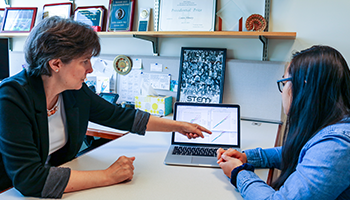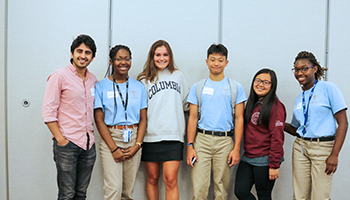HOW CAN WE HELP YOU? Call 1-800-TRY-CHOP
In This Section
A Summer for the Books: Life as a CRISSP Student at the Research Institute
 Editor’s note: The Children’s Hospital of Philadelphia Research Institute Summer Scholars Program (CRISSP) is a competitive and dynamic internship that provides undergraduate students with hands-on experience in academic research, exposure to various facets of a career in pediatric research and/or medicine, and direct mentoring by CHOP faculty. In this guest blog, Cindy Hong, a rising third-year student at University of the Sciences in Philadelphia, gives a glimpse into her experience as a 2019 CRISSP scholar embarking on the immersive 10-week internship — from learning new skills in biomedical and health informatics in the lab of Laura Almasy, PhD, to making new friends, to determining if research is a career she wants to pursue.
Editor’s note: The Children’s Hospital of Philadelphia Research Institute Summer Scholars Program (CRISSP) is a competitive and dynamic internship that provides undergraduate students with hands-on experience in academic research, exposure to various facets of a career in pediatric research and/or medicine, and direct mentoring by CHOP faculty. In this guest blog, Cindy Hong, a rising third-year student at University of the Sciences in Philadelphia, gives a glimpse into her experience as a 2019 CRISSP scholar embarking on the immersive 10-week internship — from learning new skills in biomedical and health informatics in the lab of Laura Almasy, PhD, to making new friends, to determining if research is a career she wants to pursue.
I wasn’t sure what to expect when I joined CRISSP, but this experience has definitely helped me grow as a student and a researcher through the different opportunities offered by the program.
When I read a bit about Dr. Almasy’s lab, I wanted to learn more about her neuropsychiatric disorders research. However, I had no idea how to come up with a research project on my own. Dr. Almasy guided my thinking and helped push me in the right direction while allowing enough room for me to explore my interests.
Learning how to use the computer programs needed to conduct my research seemed daunting, but I quickly caught on thanks to the support of Dr. Almasy and her colleague Dr. Alison Merikangas. They were patient and helped me work through the kinks, as I navigated a field I had no prior knowledge in.
My favorite part of research is the feeling of accomplishment when things finally start to go in the right direction. I remember feeling frustrated in the lab because I couldn’t figure out how to make one of the plots that I needed for data visualization. When I shared my discouragement with Dr. Almasy, she told me, “That’s why it’s called research — because sometimes you have to search for an answer, and when it doesn’t work out, you have to search again.”
When I finally figured out how to make the graphs, it was a small win, but it still felt amazing after working through so many failures.
Compassion and Communication in Action
Shadowing different physicians at CHOP was an important experience for me because I wanted to know more about the different fields in medicine and to determine if medicine was truly for me. My three clinical shadowing shifts included Emergency Medicine, the Intensive Care Unit, and General Surgery.
I was curious how parental factors played into children’s healthcare. Dr. Naomi Hughes spoke with me about why she went into Emergency Medicine and to what extent her job affects her personal life. I observed how she guided residents’ thinking without telling them exactly what to do. I also saw firsthand how doctors strive to provide the best emotional support they can, in light of patients’ socioeconomic issues. At CHOP, humanity and compassion are at the forefront of medical care, which I think are vital factors to patients’ ability to heal and recover.
I also shadowed Dr. Todd Kilbaugh in the ICU and observed how a medical team interacts and communicates with one another during rounds to note the risks and procedures they need to consider for the patient. I also observed the mentor-student dynamic between the attending, fellow, and residents: The fellow would encourage the residents to voice their ideas, and the attending would teach the fellow. My favorite part of critical care is all the physiology and cell biology that goes into medical decision-making. When I took freshmen biology, I didn’t think I would need to know the components of DNA beyond the MCAT and school, but this was a key idea that came up during patient rounds.
My last shadowing experience was in general surgery with Dr. Laje Pablo and several surgical nurses who kept me well informed on what procedures they were doing and the patients’ backgrounds. I observed several hernia repairs, an ovarian cyst removal, and a gallbladder removal.
In addition to the shadowing, Jodi Leckrone, my administrative partner, arranged three informational interviews with medical school students who spoke with me about what graduate school would be like in comparison to being an undergrad. Two former CRISSP students, Steven Tsai and Brenna Liley, who are Perelman School of Medicine students at the University of Pennsylvania, shared advice on how I could make the most of the CRISSP program, my time in undergrad, and ways to articulate those experiences through my applications and interview.
Sharing Perspectives
 When I learned at our CRISSP orientation breakfast about the opportunity to participate in STEM Prep mentoring, I knew I had to keep an eye out for the sign-up list to be a mentor. STEM Prep is a program for rising 11th-grade students to get an early experience in research. I mentored alongside one of my roommates, Julia Baran, and another CRISSP student, Youseff Jakher. The three of us worked to provide our mentees with advice on college planning, personal statements, and financial aid. Having two other mentors in the group was beneficial because we each came from different socioeconomic and cultural backgrounds, so we could provide students with a more holistic perspective on the college process.
When I learned at our CRISSP orientation breakfast about the opportunity to participate in STEM Prep mentoring, I knew I had to keep an eye out for the sign-up list to be a mentor. STEM Prep is a program for rising 11th-grade students to get an early experience in research. I mentored alongside one of my roommates, Julia Baran, and another CRISSP student, Youseff Jakher. The three of us worked to provide our mentees with advice on college planning, personal statements, and financial aid. Having two other mentors in the group was beneficial because we each came from different socioeconomic and cultural backgrounds, so we could provide students with a more holistic perspective on the college process.
The social events with the STEM Prep students — a game night and Quizzo night — were fun too because everyone in the CRISSP program attended and got to know the high schoolers in more relaxed settings and talk freely about our diverse college experiences. I’m glad I helped out as a mentor because I found it fulfilling to spend part of my summer doing things to benefit other young students.
Exploring the City
Before CRISSP, I had never lived away from home for more than two weeks. Living in the dorms was an affordable way for me to experience what it was like to live with people I had never met before and who had different backgrounds from my own. Besides Julia, I also shared an apartment with Emily Cid and Aishu Sritharan. I got to know Emily really well when we explored the city and attended the Chinese Lantern Festival together. We went on group outings with the other students too, such as going to the Pride parade, seeing the premier of the “Spiderman” movie, and roller skating at Penn’s Landing. I don’t think I would’ve gotten as close as I did with the other students if we didn’t have free housing in the dorms.Summing It All Up
I remember the Thursday I got the interview email for CRISSP because it was the first time I really felt accomplished. I didn’t think I had a chance of getting an interview, but here I am more than halfway through the program with so many memories, lessons, and experiences in my back pocket.
I had the incredible opportunity to live on one of the most historic campuses and to meet people from different walks of life. I had the chance to mentor incredibly brilliant and motivated high school students and to shadow different areas of medicine. I had the privilege of designing my own summer research project. And from it all, I learned how to adapt my ideas and to be open to new information. Isn’t that what research is all about?